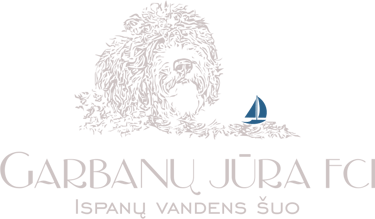
Veislės istorija
Ispanų vandens šuo (Perro de Agua Español) yra vidutinio dydžio darbšti veislė, gyvenanti Ispanijoje jau 800 metų. Jos savybės, ypatingai kailis, yra prisitaikęs prie Iberijos pusiasalio drėgmės ir sausros svyravimų.
Kaip ir dėl daugelio senovinių veislių taip ir dėl Ispanų Vandens Šunų kilmės tarp ekspertų vyksta diskusijos. Yra žinoma, kad ši universali veislė buvo išvesta Ispanijoje prieš daug amžių, kad atliktų daugybę veiklų, tokių kaip ganymas, medžioklė, vandens darbai, namų ir fermos apsauga bei tiesiog kompanijos palaikymas bei draugystė su žmogumi.
Pirmą kartą istoriniuose šaltiniuose ši veislė paminėta 1110 m., ši veislė buvo vadinama daugybe vardų: perroturco andaluz, laneto, perro de lanas, patero ir rizado, perro de agua Español, lanas, chos, chorri, cordelero ir merlucero.
Tiksli veislės kilmė nėra žinoma. De las Rosas (1993) ir Salas (1984) abu mini galimą Afrikos kilmę, pažymėdami, kad Ispanų Vandens Šunys buvo Šiaurės Afrikos genčių naudojami vandens darbam bei ganymui. De las Rosas taip pat siūlo ir kitas dvi galimas kilmes: vietinis Azijos veislės protėvių palikuonis; ir tiesioginis canis familiars palustris, iš kurio kilo visi Europos vandens šunys, palikuonis. Montesinos (1989) aprašo teoriją, kad Ispanų Vandens Šunų kilmė glūdi Turkijoje ir Vengrijoje, pažymėdamas kailio (virvių) panašumą į Vengrijos Pulį, tačiau jo teigimu tikroji kilmė yra Andalūzija. Jis taip pat teigia, kad tai pati seniausia vandens šunų veislė. Flores (1982) tiki, kad Ispanų Vandens Įuo yra tas pats kas Perro Turco minimas 10 amžiuje.
Yra dvi pagridininės hipotezės apie protėvių atvykimą į Ispaniją. Viena teigia, kad ispanų vandens šunų protėviai atvyko į ispaniją tuo metu, kai valdė maurai. Kita hipotezė tvirtina, kad protėviai atplaukė su turkų laivais 600-900 mūsų eros metais.
Populiacija buvo padalinta į dvi pagrindines Ispanijos sritis. Pirmoji dalis pasiliko Viduržemio jūros zonoje rytų Andalūzijoje ir plito į kalnų regionus, lygumas ir Gvadalkivyro upės pelkes. Antroji dalis gyveno žvejų kaimeliuose šiauriniuose šalies krantuose. Beveik neabejotinai populiacija kilo iš tos pačios kilmės, tačiau kadangi šiuos šunis turėjo sunkiai dirbantys kaimo žmonės, negalintys įpirkti specializuotų veislių šunų, ispanų vandens šunys turėjo atlikti bet kurias reikalingas regionines funkcijas.
Centriniuose ir pietiniuose regionuose, šis šuo buvo naudojamas nuginti ožkas, avis, karves ir kiaules į sezonines ganyklas, taip pat medžioti paukščius ir smulkius gyvūnus. Ispanų vandens šunys visdar gali būti sutinkami su savo pulkais centrinėse ir pietinėse kaimo vietovėse. Šiauriniuose pakrantės regionuose ispanų vandens šunų paskirtis buvo panaši į jų didžiųjų pusbrolių portugalų vandens šunų - traukti žuvį ir meškeres, iškritusias iš valties bei plukdyti valties virves į/nuo kranto prisi/atsišvartuojant. Šiauriniai šunys greičiausiai ir medžiodavo bei atlikdavo kitas fukncijas ne sezono metu. Caballero (1994) pažymi, kad ši garbanota veislė buvo naudojama Cuenca Minera del Guadioto (Sierro Morena) kasyklose mulų transporto apsaugai, apsaugai nuo vagių bei žiurkių kontrolei pačiose kasyklose. Šunų kailis būdavo paliekamas ilgas, nes taip suteikdavo jiems puikią apsaugą nuo karšto ir drėgno kasyklų oro bei apsaugodavo nuo tiesioginių saulės spindulių.
Nuo 1975, veislė buvo išgelbėta nuo nežinomybės Santiago Montesinos ir Antonio Garcia Perez'o pastangų dėka. Šunys buvo įsigyti ar "pasiskolinti' iš visų regionų, tačiau daugiausiai iš Andalūzijos piemenų ir atidžiai veisiami, kad išsaugotų veislei būdingas savybes bei darbinius gabumus. 1985 gegužės mėn. veislė buvo pripažinta Ispanijos kinologų asociacijos (Real Sociedad Central de Fomento de Razas Caninas en España) ir tais pačiais metais Madrido parodoje buvo oficialiai išstatyti pirmieji du rudi veislės atstovai. Po kelių metų veislės standartas buvo sukurtas pagal Antionio Moreno juodai baltą šunį vardu "Lucky". Tarptautinė Kinologų Federacija (F.C.I.) priskyrė šią veislę VIII grupei, 3 sekcijai (vandens šunys) kartu su pusbroliais portugalais.
Veislė buvo pilnai pripažinta Amerikos kinologų draugijos 2015 m. ir priskirta aviganių šunų grupei dėl pirminės veislės paskirties. Šiandien ši veislė laikoma universalia daugiafunkcine veisle.
Išversta iš: https://www.swdclub.org/history.html
